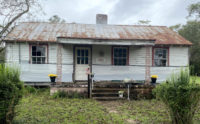The National Trust for Historic Preservation has released its 2019 list of America’s 11 Most Endangered Historic Places. Since 1988, the group has identified over 300 historic sites throughout the U.S. that are threatened by everything from neglect, insufficient funding, inappropriate development, and natural disasters.
“Our 11 Most Endangered Historic Places list has called attention to threatened one-of-a-kind treasures throughout the nation and galvanized Americans to help save them,” said Katherine Malone-France, interim chief preservation officer of the National Trust for Historic Preservation. Of those sites listed by the National Trust over the past 32 years, fewer than five percent have been lost.
The full 2019 list of America’s 11 Most Endangered Historic Places includes:
Ancestral Places of Southeast Utah
Located between two national monuments—Bears Ears and Canyons of the Ancients—this area of Southeast Utah is one of the most culturally rich but imperiled landscapes in America. If left unprotected, thousands of irreplaceable artifacts—some up to 8,000 years old—would remain threatened by the damaging impacts of oil and gas extraction.
Bismarck-Mandan Rail Bridge
Bismarck, North Dakota
Built in 1883 by George Shattuck Morison, the rail bridge was the first to span the Upper Missouri River. Rather than demolish the bridge as proposed, advocates believe the landmark should be re-purposed as a pedestrian bridge.
The Excelsior Club
Charlotte
A leading private social club for African Americans in the Southeast and a noted Green Book site since it opened in 1944, the Art Modern–style club once hosted Nat King Cole and Louis Armstrong, but today needs significant repairs.
Hacienda Los Torres
Lares, Puerto Rico
Built in 1846 and listed on the National Register of Historic Places, Hacienda Los Torres helps tell the history of economic development, class conflict, and political struggle in Puerto Rico. Built at the height of Puerto Rico's flourishing coffee industry, the structure embodies architectural characteristics, materials, and craftsmanship typical of Puerto Rico's 19th century coffee haciendas.
Industrial Trust Company Building
Providence
Dubbed the “Superman Building” due to its resemblance to the Daily Planet building from Superman comics, the iconic Art Deco tower—Rhode Island’s tallest—built by Walker & Gillette and George Frederick Hall in 1928, has been vacant since 2013 and has no current rehabilitation plans.
James R. Thompson Center
Chicago
Chicago’s foremost example of grandly scaled Post Modernism, the Helmut Jahn–designed Thompson Center is the youngest building ever to appear on this list. It currently serves as a secondary capitol for the State of Illinois, but is threatened by a sale that could lead to its demolition.
Mount Vernon Arsenal and Searcy Hospital
Mount Vernon, Alabama
Continually occupied for over 200 years and used as an arsenal, a prison, and later a psychiatric hospital, this Greek Revival–style complex closed in 2012 and currently sits vacant and awaiting preservation and re-use plans.
Nashville’s Music Row
Nashville, Tennessee
This district of late-19th century homes and small-scale commercial buildings contains more than 200 music-related businesses. Music Row’s proximity to downtown has helped the area become a hotbed for new development, resulting in 50 demolitions since 2013 and threatening the sustainability and survival of Music City’s heart and soul.
National Mall Tidal Basin
Washington, D.C.
The millions of tourists who throng to “America’s Front Yard” every year may not realize that it is threatened by rising sea levels, unstable sea walls, and outdated infrastructure. It’s estimated that as much as $500 million is needed to upgrade and maintain America’s most visited national park.
Tenth Street Historic District
Dallas
One of the rare remaining Freedmen’s towns in America, this piece of Lone Star State history is being eroded by large numbers of demolitions.
Willert Park Courts
Buffalo
In 1939, the first public housing project in New York state was made available to African American residents. A notable example of Modernism and designed by Frederick C. Backus with William E. Harris, the historic complex is currently vacant.














